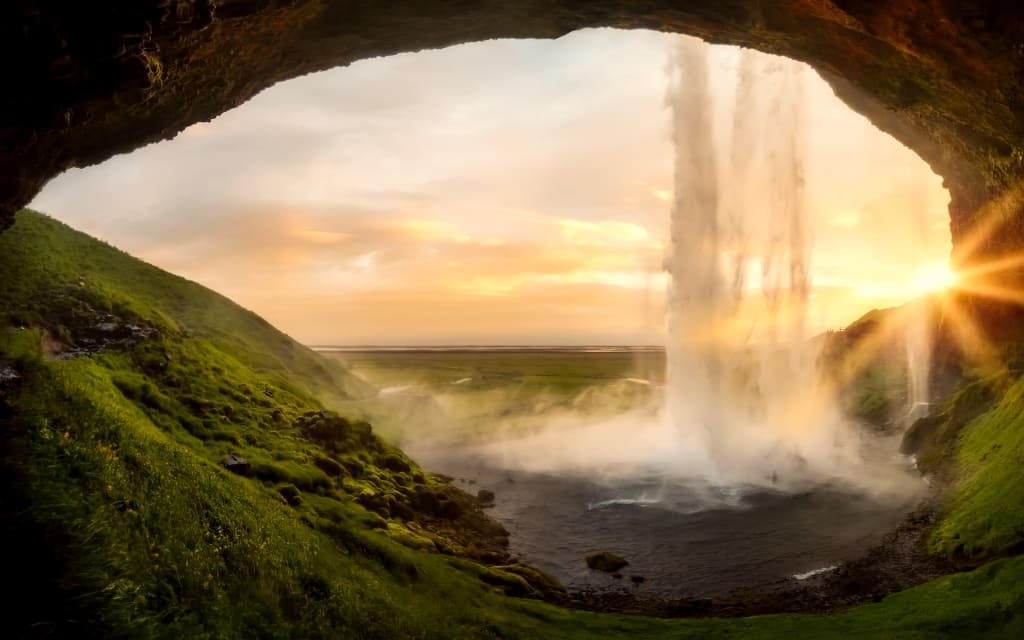Iceland, Finland and the Myths cherished by Tolkien
Edda, Sagas and Kalevala

Thingvellir: I am behind the black basalt spur, in front of the immense lichen-covered lawn where the Althing was held, the open-air parliament of the Icelanders. In the cold, sulfur-smelling air, in this asphalt-colored lava land, among pumice dunes and geyser puffs, it is necessary to make a classification of memories and mental associations that pile up confused in my head.
Let’s start with the Edda.
The term Edda, in the plural Eddur, refers to two Norse texts both written in Iceland during the thirteenth century. The poetic Edda, or ancient Edda, and the prose Edda, that of Snorri.
The ancient Edda originates from the Codex Regius, a manuscript composed in the thirteenth century, of which traces have been lost until 1643. The initial part is the known Völuspa, the prophecy of the seer, a precious source of knowledge of Norse mythology and cosmogony. The prophet talks to Odin and tells him about the creation of the world and Ragnarök, his catastrophic fate. Inside the Völuspa, six stanzas are dedicated to a list of dwarf names, from which Tolkien drew heavily for his trilogy. In 2009, Harper and Collins published Tolkien’s posthumous work on the poetic Edda, entitled “The legend of Sigurd and Gudrun”, in an English that seeks to re-propose the Norse alliterative meter.
The prose Edda, written around 1220 by Snorri Sturluson, poet and politician belonging to the Icelandic parliament, begins with a re-enactment of the myths and legends already present in the ancient Edda but then evolves into a poetic manual, aimed at understanding the mechanisms of heraldic poetry.
Derived from the Icelandic voice skald, i.e. poet, Scaldic poetry is complex, intricate, alliterative, often composed in praise of a particular gentleman. Kenningar abounds, that is, hermetic metaphors, poetic and imaginative periphrases that replace the name of a thing. The use of Kenning is common in Norse, Celtic and Anglo-Saxon literature, examples are also found in the Beowulf, and the scaldic poetry approaches the trobadoric and Provencal one.
Snorri is also known for claiming that the gods were nothing but military leaders who were revered (in this proposing the theory of the philosopher Euhemerus).
Let’s deal with the Icelandic Sagas now.
The literary form closest to the modern novel that took place in the Middle Ages, capable of even coining a new term, is precisely the “saga”, which has at its root the verb “to say”.
The Islendigasögur are family stories — written on sheepskin in a period from the twelfth to the fourteenth century — that speak of people who really existed, of events that occurred to the first generations of settlers who moved from Norway to Iceland, of adventurous trips to Greenland and North America (before Christopher Columbus), of the impatience towards the Norwegian and Danish kings, of the raids carried out to conquer land, booty and independence.
The society described is similar to the eighteenth-century bourgeoisie in which the genre of the novel will take hold.
“The society imagined by the Islanding sour is as precisely observed as those of Daniel Defoe and Jane Austen”. (Robert Kellog)
From the sagas we learn history, geography but also minute details of the daily life of the time, complicated family relationships, the concept of honour, the power of godi, halfway between priests and political leaders.
Both the two books of the Edda and the Icelandic Sagas are attempts to preserve the tradition of the pagan past operated during an already Christian Middle Ages.
Contemporary of Chrétien de Troyes, Chaucer and Dante, they are not written for an aristocratic audience but for ordinary people, just like the novel. The sagas are the product of the people, of farmers and fishermen who sat around the fire in the evening and recalled the deeds of ancestors and famous people. The protagonists are not semi-divine heroes but farmers and landowners, a male universe of rough fighters and outlaws, although some stories also give space to female heroines.
If in spirit they recall the epic, they are not in verse but in a prose that mixes irony, humour and nostalgia. They differ from medieval romance by the lack of attention given to imagination and courtly love and the lack of a happy ending.
They host, however, many magical and fantastic elements, some of which were taken up by Tolkien: the trolls, the ghosts, the Berserkers, or fierce Scandinavian warriors who had sworn an oath to Odin.
The most famous is the Egils saga, considered by many to be Snorri’s work. Egil Skallagrimsson was the largest Icelandic skald. Many of the heroes mentioned in the sagas were also poets, capable of reciting celebratory verses, but not falsely flatterers, in honour of their sovereigns. And yet the words were also used as weapons to hurt and humiliate.
The authors of the sagas are unknown and the stories were first handed down orally and then, only later, collected in writing, after the introduction of writing on the island in the twelfth century but, even on this, there is no certainty. The same concept of author is very different from the current one, indicating only the “initiator” of a story, which does not mark the subject with his personal style.
Prose like that of the sagas was rare in the literature of the period, except for the Decameron and the French vulgar of the Arthurian cycle.
“The development of a prose fiction in medieval Iceland that was fluent, nuanced and seriously occupied with the legal, moral and political life of a whole society of ordinary people was an achievement unparalleled elsewhere in Europe.” (Robert Kellog)
Stories never begin in medias res but try to tell the events in chronological order. The language is direct and simple, large space is given to dialogue. The characters are introduced by a complicated genealogy and surname, which Tolkien recovers and develops in the appendices. One of the functions of the sagas was also the transmission of these genealogies, and they had a didactic purpose as well as entertainment.
Usually the saga opens abruptly, with a banal introduction: “There was a man named etc”. The accuracy in the geographical location of the story and in identifying the exact historical context is maximum. The story tells of a conflict, born out of trivial and common questions, of its bloody development and of feuds and subsequent vendettas. The characters, however, retain something mythical, magical skills in their singing, divinatory power.
Although, as we said, they are mainly in prose, they also contain verses within them, initially seen as a source of information and historical authority, which later became a means of expression of the mind and thoughts of the protagonists.
We conclude with the much more recent Kalevala.
In 1835 Elias Lönrot rearranged and published a vast collection of heroic Karelian ballads in the form of a poem. The next version, from 1849, is more complete. The Karelians are Finns who have had contact — coincidentally — with the Vikings. Their language, belonging to the Finno-Ugric group, is not of Indo-European origin. Kalevala means “Land of Kaleva”, in other words Finland.
Also in this case it is the recovery of ancient traditions and ancient songs. The poem is still sung by some elderly bards with shamanic valences.
The story of the hero and poet Väinamöinen, the blacksmith Ilmarinen and the warrior Lemminkäinen partly inspired the American poet Longfellow, the composer Sibelius and, finally, Tolkien with “The Silmarillion” and the structure of the elven languages. Everything revolves around the search for a bride for the heroes and the Sampo, a magic mill that ensures wealth for those who own it.
There are many adaptations and reductions for children, in particular we like to remember the one published in 1961 for the types of Malipiero, of which we report an excerpt:
“The intrepid old man Vainamonen, immensely strong, was the singer of Kalevala” (By singer we mean a scaldo, a poet similar to those present in the Icelandic Edda and Sagas, who also has magical and thaumaturgical skills in his hand). “His hand was like the sky, covered the whole greater region of Kalevala, and covered it by day and by night, like a strong wind capable of uttering words to music that everyone could hear even locked inside the huts. His fame went far, like water spreading over the plains. Thus it reached the lands of midday, in the places of Poiola. “
About the Creator
Patrizia Poli
Patrizia Poli was born in Livorno in 1961. Writer of fiction and blogger, she published seven novels.







Comments (2)
Thank you!
Thanks for sharing 😊 It was a great read. All the best and happy writing.